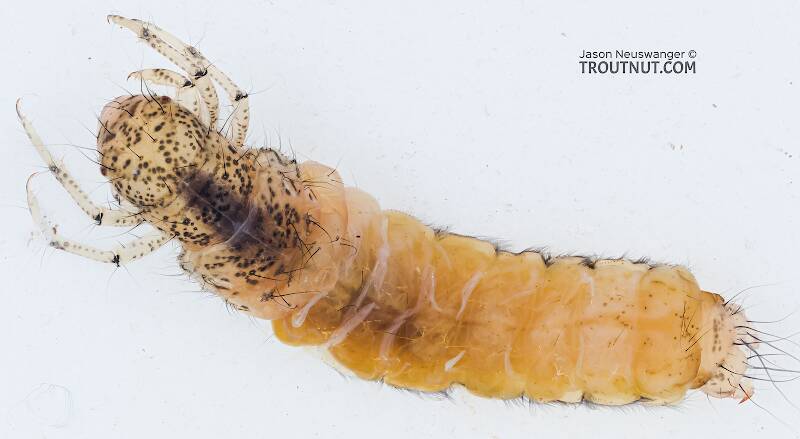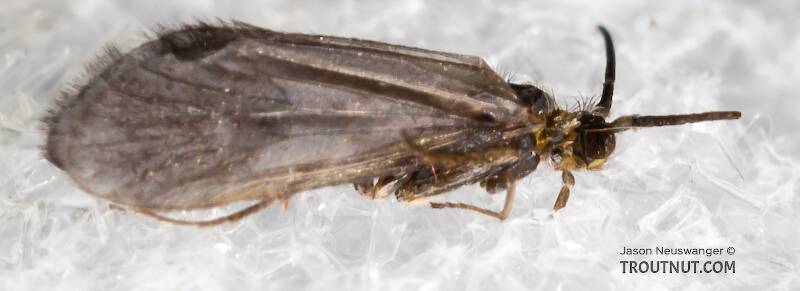
Blue-winged Olives
Baetis
Tiny Baetis mayflies are perhaps the most commonly encountered and imitated by anglers on all American trout streams due to their great abundance, widespread distribution, and trout-friendly emergence habits.
Featured on the forum

This is a striking caddis larva with an interesting color pattern on the head. Here are some characteristics I was able to see under the microscope, but could not easily expose for a picture:
- The prosternal horn is present.
- The mandible is clearly toothed, not formed into a uniform scraper blade.
- The seems to be only 2 major setae on the ventral edge of the hind femur.
- Chloride epithelia seem to be absent from the dorsal side of any abdominal segments.
Based on these characteristics and the ones more easily visible from the pictures, this seems to be Grammotaulius. The key's description of the case is spot-on: "Case cylindrical, made of longitudinally arranged sedge or similar leaves," as is the description of the markings on the head, "Dorsum of head light brownish yellow with numerous discrete, small, dark spots." The spot pattern on the head is a very good match to figure 19.312 of Merritt R.W., Cummins, K.W., and Berg, M.B. (2019). The species ID is based on Grammotaulius betteni being the only species of this genus known in Washington state.
- The prosternal horn is present.
- The mandible is clearly toothed, not formed into a uniform scraper blade.
- The seems to be only 2 major setae on the ventral edge of the hind femur.
- Chloride epithelia seem to be absent from the dorsal side of any abdominal segments.
Based on these characteristics and the ones more easily visible from the pictures, this seems to be Grammotaulius. The key's description of the case is spot-on: "Case cylindrical, made of longitudinally arranged sedge or similar leaves," as is the description of the markings on the head, "Dorsum of head light brownish yellow with numerous discrete, small, dark spots." The spot pattern on the head is a very good match to figure 19.312 of Merritt R.W., Cummins, K.W., and Berg, M.B. (2019). The species ID is based on Grammotaulius betteni being the only species of this genus known in Washington state.

Troutnut is a project started in 2003 by salmonid ecologist Jason "Troutnut" Neuswanger to help anglers and
fly tyers unabashedly embrace the entomological side of the sport. Learn more about Troutnut or
support the project for an enhanced experience here.
Caddisfly Species Amiocentrus aspilus (Little Western Weedy Water Sedges)
This species produces fishable hatches across the West.
I encountered them in mid-August on the Henry's Fork, mating in thick swarms up and down the bank of the Harriman Ranch reach. However, millions of Tricorythodes mayflies found their way onto the water that same morning and it's unclear if the trout were seeing and responding to the caddisflies at all.
I encountered them in mid-August on the Henry's Fork, mating in thick swarms up and down the bank of the Harriman Ranch reach. However, millions of Tricorythodes mayflies found their way onto the water that same morning and it's unclear if the trout were seeing and responding to the caddisflies at all.
Where & when
Time of year : March to October; LaFontaine reports peaks in late June and in September
Preferred waters: Best in spring creeks
In 23 records from GBIF, adults of this species have mostly been collected during July (35%), August (30%), May (13%), June (9%), and March (9%).
In 4 records from GBIF, this species has been collected at elevations of 6060, 6250, 6726, and 7005 ft.
Species Range
Larva & pupa biology
Substrate: Vegetation
Specimens of the Caddisfly Species Amiocentrus aspilus
1 Adult
Start a Discussion of Amiocentrus aspilus
References
- LaFontaine, Gary. 1981. Caddisflies. The Lyons Press.
- Merritt R.W., Cummins, K.W., and Berg, M.B. 2019. An Introduction to the Aquatic Insects of North America (Fifth Edition). Kendall/Hunt Publishing Company.
Caddisfly Species Amiocentrus aspilus (Little Western Weedy Water Sedges)
Species Range
Common Name
Resources
- NatureServe
- Integrated Taxonomic Information System
- Global Biodiversity Information Facility
- Described by Ross (1938)


